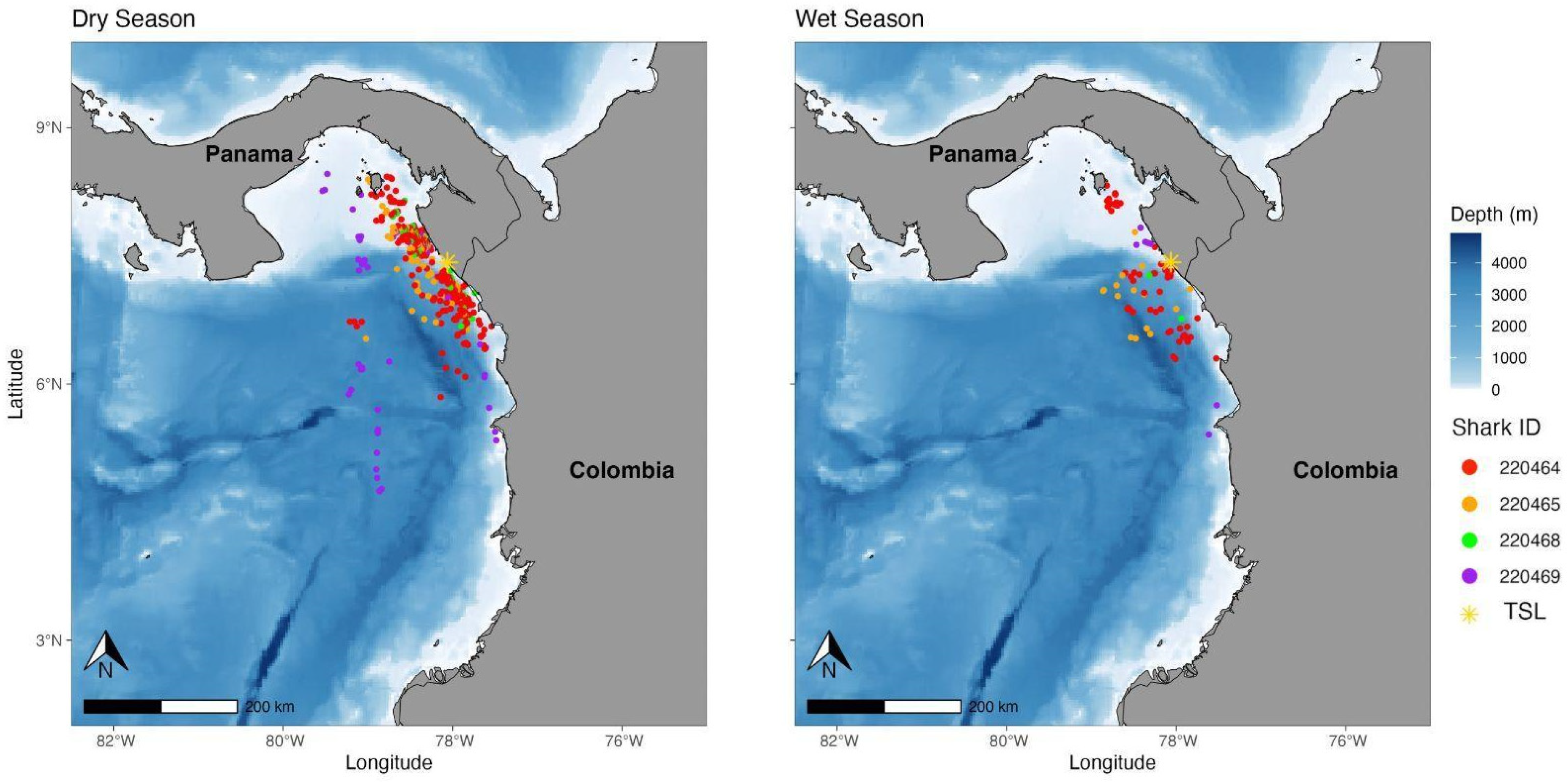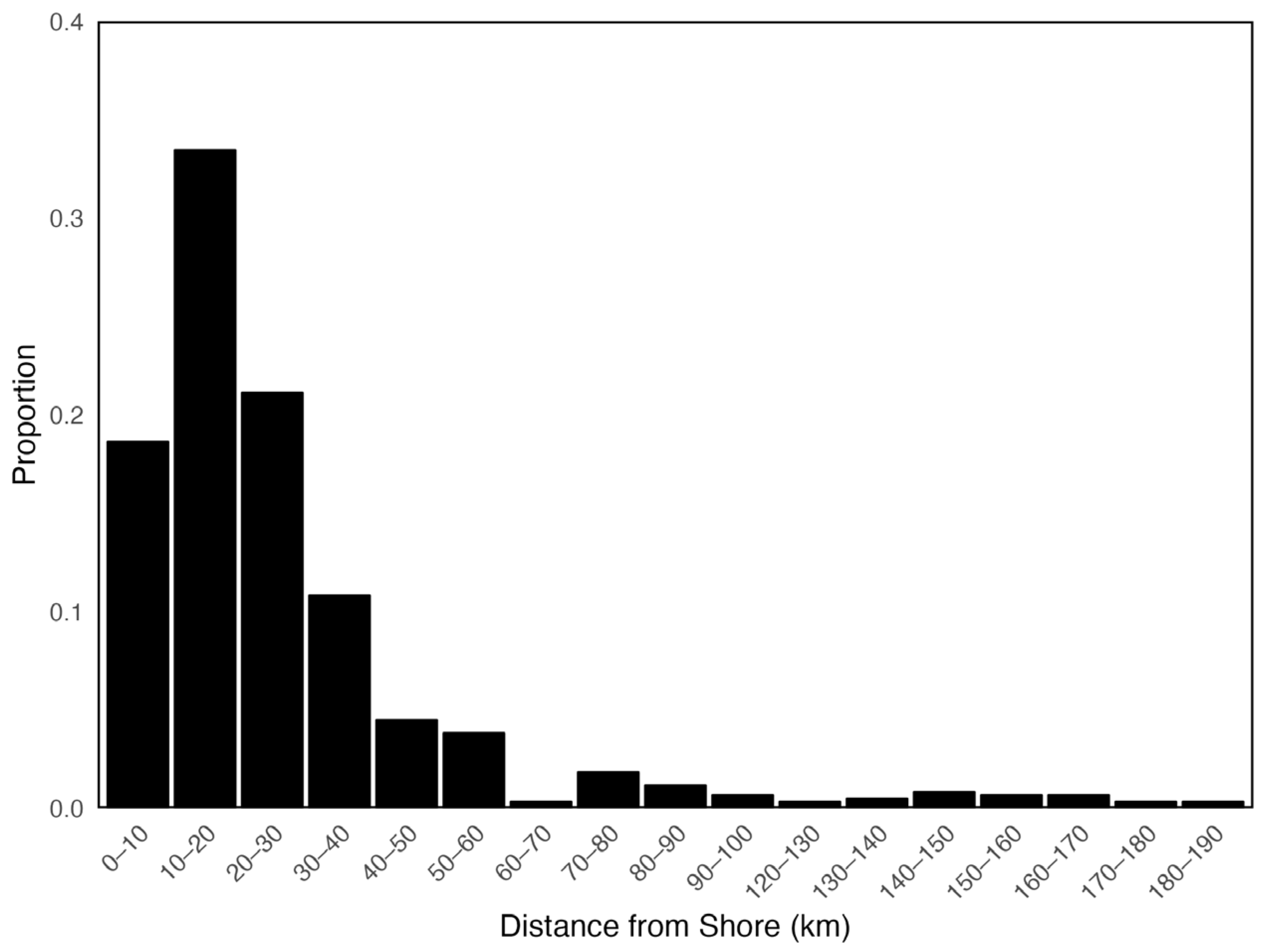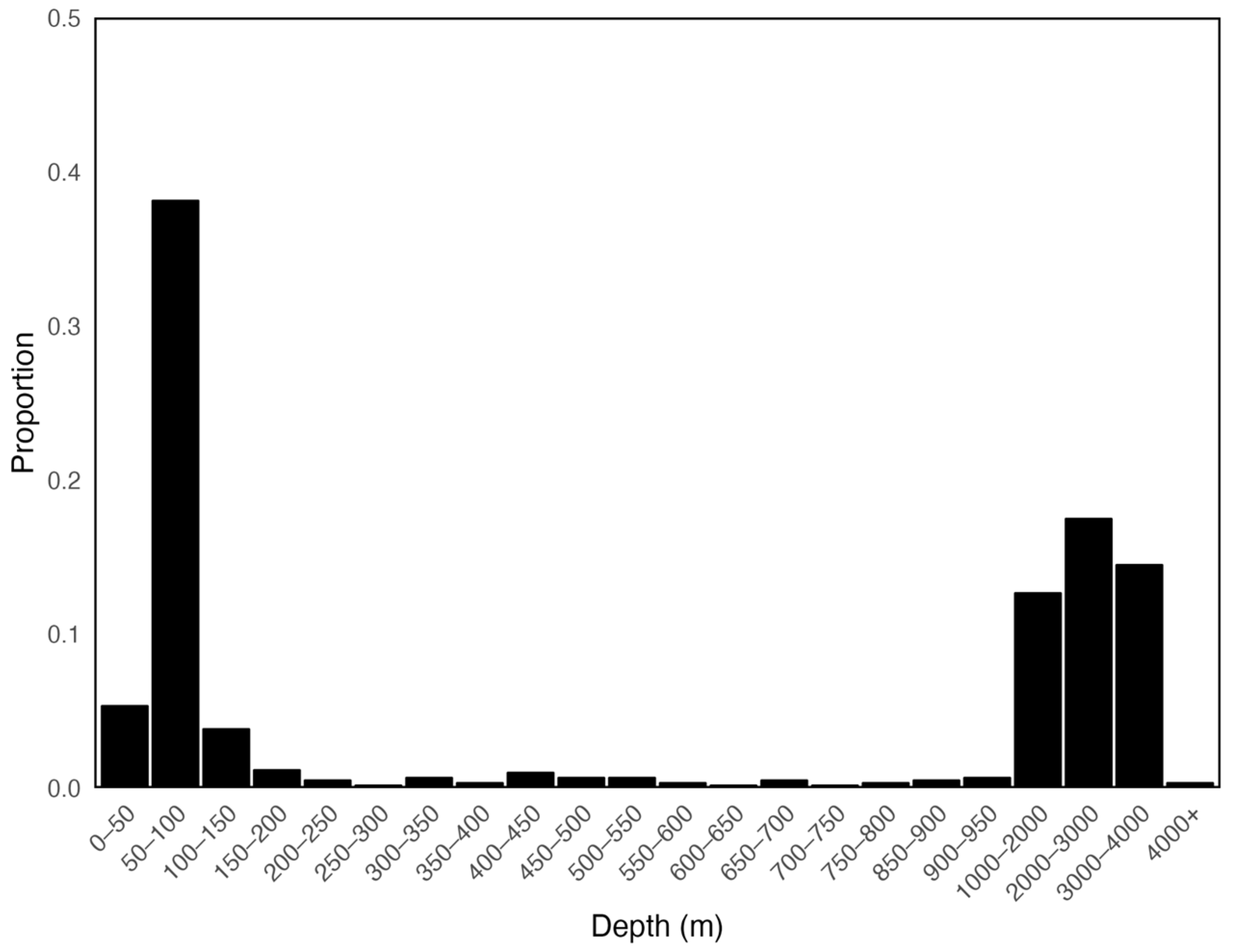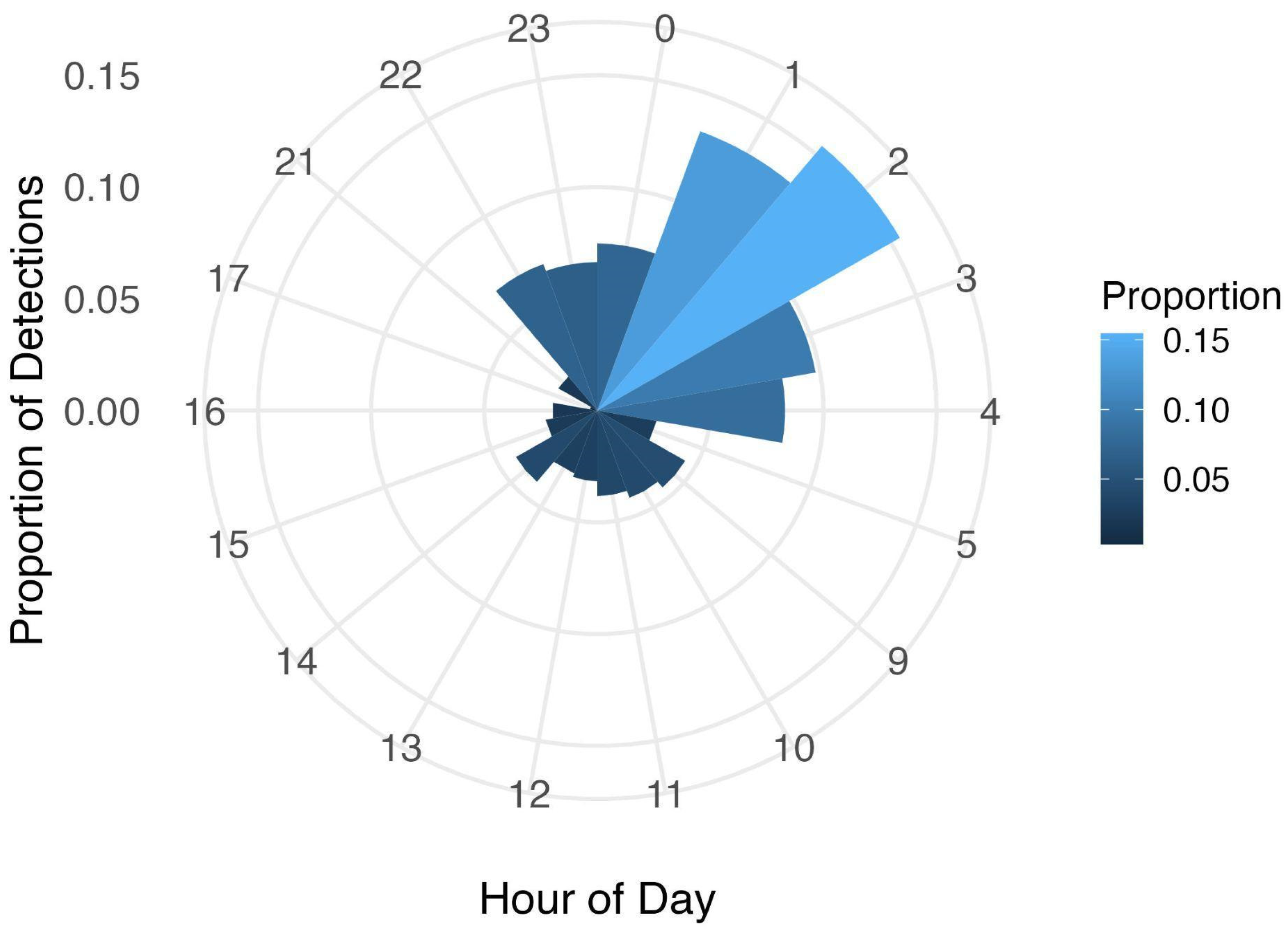Movements of Galapagos Sharks (Carcharhinus galapagensis) in Eastern Tropical Pacific Waters off Central and South America
Abstract
1. Introduction
2. Materials and Methods
3. Results
4. Discussion
5. Conclusions
Author Contributions
Funding
Institutional Review Board Statement
Data Availability Statement
Acknowledgments
Conflicts of Interest
References
- Compagno, L.J. FAO species catalogue. In Sharks of the World. An Annotated and Illustrated Catalogue of Shark Species Known to Date; Part 2. Carcharhiniformes; FAO: Rome, Italy, 1984; Volume 4. [Google Scholar]
- Ebert, D.A.; Dando, M.; Fowler, S. Sharks of the World: A Complete Guide; Princeton University Press: Princeton, NJ, USA, 2021; Volume 19. [Google Scholar]
- Mitchell, J.D.; Camilieri-Asch, V.; Gudge, S.; Jaine, F.R.A.; Peddemors, V.M.; Langlois, T.J. Applying acoustic telemetry, vessel tracking and fisher knowledge to investigate and manage fisher-shark conflict at Lord Howe Island, Australia. Mar. Biol. 2024, 171, 230. [Google Scholar] [CrossRef]
- Morales, N.A.; Heidemeyer, M.; Bauer, R.; Hernández, S.; Acuña, E.; van Gennip, S.J.; Friedlander, A.M.; Gaymer, C.F. Residential movements of top predators in Chile’s most isolated marine protected area: Implications for the conservation of the Galapagos shark, Carcharhinus galapagensis, and the yellowtail amberjack, Seriola lalandi. Aquat. Conserv. Mar. Freshw. Ecosyst. 2021, 31, 340–355. [Google Scholar] [CrossRef]
- Wetherbee, B.M.; Crow, G.L.; Lowe, C.G. Biology of the Galapagos shark, Carcharhinus galapagensis, in Hawai’i. Environ. Biol. Fishes 1996, 45, 299–310. [Google Scholar] [CrossRef]
- Ketchum, J.T.; Hoyos-Padilla, M.; Aldana-Moreno, A.; Ayres, K.; Galván-Magaña, F.; Hearn, A.; Lara-Lizardi, F.; Muntaner-López, G.; Grau, M.; Trejo-Ramírez, A.; et al. Shark movement patterns in the Mexican Pacific: A conservation and management perspective. Adv. Mar. Biol. 2020, 85, 1–37. [Google Scholar] [PubMed]
- Limbaugh, C. Field notes on sharks. In Sharks and Survival; Gilbert, P.W., Garrick, J.A.F., Schultz, L.P., Eds.; D.C. Heath Co.: Boston, MA, USA, 1963; pp. 53–94. [Google Scholar]
- Hobbs, J.P.A.; Choat, J.H.; Robbins, W.D.; Ayling, A.M.; Van Herwerden, L.; Feary, D.A. Unique fish assemblages at world’s southernmost oceanic coral reefs, Elizabeth and Middleton Reefs, Tasman Sea, Australia. Coral Reefs 2008, 27, 15. [Google Scholar] [CrossRef]
- Papastamatiou, Y.P.; Wetherbee, B.M.; Lowe, C.G.; Crow, G.L. Distribution and diet of four species of carcharhinid shark in the Hawaiian Islands: Evidence for resource partitioning and competitive exclusion. Mar. Ecol. Prog. Ser. 2006, 320, 239–251. [Google Scholar] [CrossRef]
- Compagno, L.J. Sharks of the Order Carcharhiniformes; Blackburn Press: Caldwell, NJ, USA, 2003. [Google Scholar]
- Garrick, J.A.F. Sharks of the genus Carcharhinus; NOAA Technical Report NMFS CIRC 445: Seattle, WA, USA, 1982. [Google Scholar]
- Pazmiño, D.A.; van Herwerden, L.; Simpfendorfer, C.A.; Junge, C.; Donnellan, S.C.; Hoyos-Padilla, E.M.; Duffy, C.A.; Huveneers, C.; Gillanders, B.M.; Butcher, P.A.; et al. Introgressive hybridisation between two widespread sharks in the east Pacific region. Mol. Phylogenetics Evol. 2019, 136, 119–127. [Google Scholar] [CrossRef]
- Taniuchi, T.; Tachikawa, H.; Kurata, Y.; Nose, Y. Galapagos shark, Carcharhinus galapagensis, from the Ogasawara Islands, Japan. Jpn. J. Ichthyol. 1985, 31, 449–452. [Google Scholar]
- Bass, A.J.; D’Aubrey, J.D.; Kistnasamy, N. Sharks of the east coast of southern Africa. I. The genus Carcharhinus (Carcharhinidae). Investig. Rep. Oceanogr. Res. Inst. 1973, 33, 8–9. [Google Scholar]
- Pazmiño, D.A.; Maes, G.E.; Simpfendorfer, C.A.; Salinas-de-León, P.; van Herwerden, L. Genome-wide SNPs reveal low effective population size within confined management units of the highly vagile Galapagos shark (Carcharhinus galapagensis). Conserv. Genet. 2017, 18, 1151–1163. [Google Scholar] [CrossRef]
- Pazmiño, D.A.; Maes, G.E.; Green, M.E.; Simpfendorfer, C.A.; Hoyos-Padilla, E.M.; Duffy, C.J.; Meyer, C.G.; Kerwath, S.E.; Salinas-de-León, P.; Van Herwerden, L. Strong trans-Pacific break and local conservation units in the Galapagos shark (Carcharhinus galapagensis) revealed by genome-wide cytonuclear markers. Heredity 2018, 120, 407–421. [Google Scholar] [CrossRef] [PubMed]
- Van Herwerden, L.; Almojil, D.; Choat, H. Population genetic structure of Australian Galápagos reef sharks Carcharhinus galapagensis at Elizabeth and Middleton Reefs Marine National Nature Reserve and Lord Howe Island Marine Park. In Final Report to the Department of the Environment, Water, Heritage and the Arts; Queensland; Molecular Ecology and Evolution Laboratory, School of Marine and Tropical Biology, James Cook University: Townsville, Australia, 2008. [Google Scholar]
- Meyer, C.G.; Papastamatiou, Y.P.; Holland, K.N. A multiple instrument approach to quantifying the movement patterns and habitat use of tiger (Galeocerdo cuvier) and Galapagos sharks (Carcharhinus galapagensis) at French Frigate Shoals, Hawaii. Mar. Biol. 2010, 157, 1857–1868. [Google Scholar] [CrossRef]
- Jacoby, D.M.; Watanabe, Y.Y.; Packard, T.; Healey, M.; Papastamatiou, Y.P.; Gallagher, A.J. First descriptions of the seasonal habitat use and residency of scalloped hammerhead (Sphyrna lewini) and Galapagos sharks (Carcharhinus galapagensis) at a coastal seamount off Japan. Anim. Biotelemetry 2022, 10, 22. [Google Scholar] [CrossRef]
- Lara-Lizardi, F.; Hoyos-Padilla, M.; Hearn, A.; Klimley, A.P.; Galván-Magaña, F.; Arauz, R.; Bessudo, S.; Castro, E.; Clua, E.; Espinoza, E.; et al. Shark movements in the Revillagigedo Archipelago and connectivity with the Eastern Tropical Pacific. bioRxiv 2020, in press. [Google Scholar] [CrossRef]
- Klimley, A.P.; Arauz, R.; Bessudo, S.; Chávez, E.J.; Chinacalle, N.; Espinoza, E.; Green, J.; Hearn, A.R.; Hoyos-Padilla, M.E.; Nalesso, E.; et al. Studies of the movement ecology of sharks justify the existence and expansion of marine protected areas in the Eastern Pacific Ocean. Environ. Biol. Fishes 2022, 105, 2133–2153. [Google Scholar] [CrossRef]
- Lowe, C.G.; Wetherbee, B.M.; Meyer, C.G. Using acoustic telemetry monitoring techniques to quantify movement patterns and site fidelity of sharks and giant trevally around French Frigate Shoals and Midway Atoll. Atoll Res. Bull. 2006, 543, 281–303. [Google Scholar]
- Morales-Serrano, N.; Gonzalez-Pestana, A. Identification of the first nursery area of the Galápagos shark (Carcharhinus galapagensis) in the south-east Pacific Ocean. J. Fish Biol. 2024, 105, 1008–1013. [Google Scholar] [CrossRef]
- Guzman, H.M.; Cipriani, R.; Vega, A.J.; Morales-Saldaña, J.M. Fisheries and conservation assessment of sharks in Pacific Panama. Aquat. Conserv. Mar. Freshw. Ecosyst. 2020, 30, 315–330. [Google Scholar] [CrossRef]
- Morales-Saldaña, J.; Guzmán, H.; Vega, A.; Robles, Y.; Montes, L.; Kyne, P. A review of the status of sharks, rays and chimaeras of Panama to guide research and conservation. Aquat. Conserv. Mar. Freshw. Ecosyst. 2025, 35, e70122. [Google Scholar] [CrossRef]
- Rojas, J.R.; Campos, J.; Segura, Á.; Mug, M.; Campos, R.; Rodríguez, O. Shark fisheries in Central America a review and update. Uniciencia 2000, 17, 49–56. [Google Scholar]
- CLS (Collecte Localisation Satellites). Argos User’s Manual. 2017. Available online: http://www.argos-system.org/manual/ (accessed on 10 March 2025).
- RStudio Team. RStudio: Integrated Development for R. RStudio, PBC. 2020. Available online: https://www.rstudio.com (accessed on 10 March 2025).
- Parra, R.R.T.; Usta, D.F.B.; Díaz, L.J.O.; Moreno-Ardila, M.P. Eastern Tropical Pacific atmospheric and oceanic projected changes based on CMIP6 models. Prog. Oceanogr. 2024, 229, 103362. [Google Scholar] [CrossRef]
- Chamberlain, S.; Tupper, B.; Mendelssohn, R. Rerddap: General Purpose Client for “ERDDAP” Servers (1.2.1). 2021. Available online: https://CRAN.R-project.org/package=rerddap (accessed on 10 March 2025).
- Mendelssohn, R. Rerddapxtracto: Extracts Environmental Data from “ERDDAP” Web Services (1.2.3). 2022. Available online: https://CRAN.R-project.org/package=rerddapXtracto (accessed on 10 March 2025).
- Luiz, O.J.; Edwards, A.J. Extinction of a shark population in the Archipelago of Saint Paul’s Rocks (equatorial Atlantic) inferred from the historical record. Biol. Conserv. 2011, 144, 2873–2881. [Google Scholar] [CrossRef]
- Robbins, W.D.; Peddemors, V.M.; Kennelly, S.J. Assessment of permanent magnets and electropositive metals to reduce the line-based capture of Galapagos sharks, Carcharhinus galapagensis. Fish. Res. 2011, 109, 100–106. [Google Scholar] [CrossRef]
- Zylich, K.; Harper, S.; Lidandeo, R.; Vega, R.; Zeller, D.; Pauly, D. Fishing in Easter Island, a recent history (1950–2010). Lat. Am. J. Aquat. Res. 2014, 42, 845–856. [Google Scholar] [CrossRef]
- Kato, S.; Carvallo, A.H. Shark tagging in the eastern Pacific Ocean, 1962–1965. In Sharks, Skates, and Rays; Gilbert, P.W., Matheson, R.F., Rall, D.P., Eds.; Johns Hopkins University Press: Baltimore, MD, USA, 1967; pp. 93–109. [Google Scholar]
- Kohler, N.E.; Casey, J.G.; Turner, P.A. NMFS cooperative shark tagging program, 1962–93: An atlas of shark tag and recapture data. Mar. Fish. Rev. 1998, 60, 1–87. [Google Scholar]
- de Queiroz, J.D.; Bezerra, N.P.; Macena, B.C.; Hazin, F.H. Back from the dead? Not really. The tale of the Galapagos shark (Carcharhinus galapagensis) in a remote Brazilian archipelago. Biol. Conserv. 2021, 256, 109097. [Google Scholar] [CrossRef]
- Dwyer, R.G.; Campbell, H.A.; Irwin, T.R.; Franklin, C.E. Does the telemetry technology matter? Comparing estimates of aquatic animal space-use generated from GPS-based and passive acoustic tracking. Mar. Freshw. Res. 2015, 66, 654–664. [Google Scholar] [CrossRef]
- Hardin, E.E.; Cullen, J.A.; Fuentes, M.M. Comparing acoustic and satellite telemetry: An analysis quantifying the space use of Chelonia mydas in Bimini, Bahamas. R. Soc. Open Sci. 2024, 11, 231152. [Google Scholar] [CrossRef]
- Dale, J.J.; Stankus, A.M.; Burns, M.S.; Meyer, C.G. The Shark assemblage at French Frigate Shoals Atoll, Hawai‘i: Species composition, abundance and habitat use. PLoS ONE 2011, 6, e16962. [Google Scholar] [CrossRef]
- Green, M.E. A Mitochondrial and Genome Wide Genetic Investigation of Galapagos Shark (Carcharhinus galapagensis) Populations in the Southwest Pacific Ocean. Master’s Thesis, James Cook University, Townsville, Australia, 2014. [Google Scholar]






| Shark Number | Argos ID | TL (cm) | Sex | Date Tagged | Tagging Latitude | Tagging Longitude | Last Detection | Track Duration (days) | Total Detections | Detections in Wet Season (May–November) | Detections in Dry Season (December–April) |
|---|---|---|---|---|---|---|---|---|---|---|---|
| 1 | 220464 | 213 | F | 09/13/2023 | 7.5717 | −78.3316 | 03/05/2025 | 580 | 368 | 64 | 304 |
| 2 | 220465 | 183 | F | 09/14/2023 | 7.5717 | −78.3316 | 02/13/2025 | 518 | 97 | 16 | 81 |
| 3 | 220468 | 198 | F | 09/13/2023 | 7.5717 | −78.3316 | 08/09/2024 | 331 | 51 | 2 | 49 |
| 4 | 220469 | 183 | M | 09/13/2023 | 7.5717 | −78.3316 | 05/14/2024 | 244 | 70 | 8 | 62 |
Disclaimer/Publisher’s Note: The statements, opinions and data contained in all publications are solely those of the individual author(s) and contributor(s) and not of MDPI and/or the editor(s). MDPI and/or the editor(s) disclaim responsibility for any injury to people or property resulting from any ideas, methods, instructions or products referred to in the content. |
© 2025 by the authors. Licensee MDPI, Basel, Switzerland. This article is an open access article distributed under the terms and conditions of the Creative Commons Attribution (CC BY) license (https://creativecommons.org/licenses/by/4.0/).
Share and Cite
Wetherbee, B.M.; Harvey, G.M.C.; Kresge, C.D.; Brantley, M.K.; Fleischer, O.W.; Kobasa, N.A.; Vaudo, J.J.; Shivji, M.S. Movements of Galapagos Sharks (Carcharhinus galapagensis) in Eastern Tropical Pacific Waters off Central and South America. Fishes 2025, 10, 459. https://doi.org/10.3390/fishes10090459
Wetherbee BM, Harvey GMC, Kresge CD, Brantley MK, Fleischer OW, Kobasa NA, Vaudo JJ, Shivji MS. Movements of Galapagos Sharks (Carcharhinus galapagensis) in Eastern Tropical Pacific Waters off Central and South America. Fishes. 2025; 10(9):459. https://doi.org/10.3390/fishes10090459
Chicago/Turabian StyleWetherbee, Bradley M., Guy M.C. Harvey, Colby D. Kresge, Mary K. Brantley, Owen W. Fleischer, Nicole A. Kobasa, Jeremy J. Vaudo, and Mahmood S. Shivji. 2025. "Movements of Galapagos Sharks (Carcharhinus galapagensis) in Eastern Tropical Pacific Waters off Central and South America" Fishes 10, no. 9: 459. https://doi.org/10.3390/fishes10090459
APA StyleWetherbee, B. M., Harvey, G. M. C., Kresge, C. D., Brantley, M. K., Fleischer, O. W., Kobasa, N. A., Vaudo, J. J., & Shivji, M. S. (2025). Movements of Galapagos Sharks (Carcharhinus galapagensis) in Eastern Tropical Pacific Waters off Central and South America. Fishes, 10(9), 459. https://doi.org/10.3390/fishes10090459







